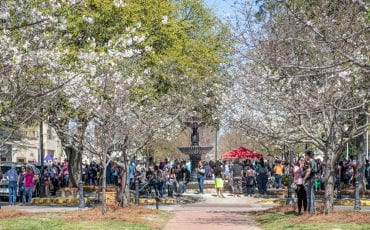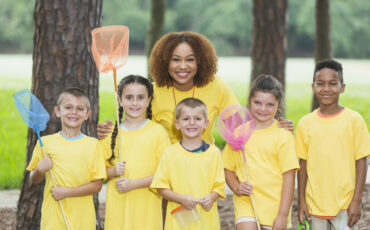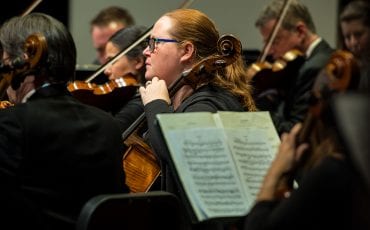Childhood Cancer: Follow These Families’ Journeys

The Glee Family
Hearing a doctor say that their child has cancer is something that no parent expects. Navigating the journey is a confusing, heartbreaking and stressful time. We asked three families to share their experiences.
Table of Contents
The Doukov Family

Diana Doukov
Kostadin Doukov never expected to be out walking with his 5-year-old on a Friday and then taking his 5-month-old to the hospital to be diagnosed with bilateral Wilm’s tumor. “Life prepares you for so many things, but not this,” he says. “It just hits you. For any reasonable parent, your world just stops and your child leads the way.”
Diana was diagnosed with bilateral Wilm’s tumor, a cancer that starts in the kidneys when the white blood cells grow out of control. Her tumor was three times the size of her kidneys. It is the most common of the childhood kidney cancers and usually affects only one kidney. But Diana was affected in both. She went through 12 weeks of chemo followed by a partial removal of her kidney. She continued chemo for nine months; currently she is in remission.
“One thing I learned is that cancer changes day-to-day life. Obviously you become focused on the cure and the availability of treatment and procedures. There are so many decisions a parent has to make, especially the first several weeks. There are no prescribed treatments like for an adult, so it’s at the discretion of the oncologist.”
During treatment Diana’s system was weak and had to be protected, so Kos’ wife decided to stop working and stay at home. “We had the financial ability to do that but I know a lot of parents who have had to sell their businesses, their homes, everything to help pay for their child’s treatment. I could do anything that was best for my daughter. A lot of parents are not in that situation, and I’m not blind to that.”
Kos said CURE helps in so many ways, from its research to supporting families. “There’s so much pain, and they have so much empathy for the families. Again, we had support – from our families, my firm, colleagues – but others didn’t, and CURE fills the gap. It’s as simple as when your child goes to chemo, where are you going to sleep the night before? Where do you park your car? What happens to your other kids? There are so many examples of how they go above and beyond the treatment plan.”
Diana is lucky that she will probably not remember much of her treatments. “She won’t have the memories of, say, a teenager who does know what’s happening and their pain is so much more significant.”
Diana is still not out of the woods. She is reaching and exceeding her development milestones, but she will have to be monitored for the rest of her life. The next six years are “risky,” and there is a fear it will come back. “We try not to think about that,” Kos says. “We’ve learned to live with it, and we’re glad she is definitely much better and doing extremely well.”
The Connor Family

Caroline Connor
Caroline Connor barely knows a life without cancer. The 6-year-old was diagnosed with juvenile pilocytic astrocytoma (JPA), a rare brain tumor, three days after her first birthday. Since then she has undergone several chemotherapy and immunization treatments, as well as trying new drugs, some still in the research phase, because
the standard options weren’t working.
“She has experienced all those things that someone with cancer would experience. Hair loss, vomiting, horrible rashes,” says her mother, Camille Connor. “The last research drug did horrible things to her body. She had a rash all over her body. We had to treat her like a burn patient and wrap her legs.”
Caroline is on a new drug that has stabilized the tumor, and there are signs it may be reducing it. “We’re in a great place right now,” says Camille. “The side effects from this drug have been mild and she’s able to live like a normal 6-year-old.”
JPA is a slow-growing tumor that tends to be benign; Caroline’s was not. Unfortunately, Caroline’s tumor was inoperable. The Connors were told there was a 2 to 3% chance it would metastasize. “It wasn’t a big window,” Camille says. “But hers did.”
Caroline, her identical twin and her older brother all went through Caroline’s journey as a family. “We’ve never hidden it. We made a decision as a family to talk about it and what it was. Caroline’s beginning to understand why she has to take a shot every week and go to the doctor. She knows it doesn’t feel good, but it will feel worse if the brain tumor grows.”
Helping her through the process was her involvement with CURE. “They understand what families are going through. They’ll give you a bag of information and a chicken sandwich and tell you that you can open the bag or not; it’s up to you.”
That bag proved to be a lifeline to normalcy. “It had toiletries when you didn’t figure you needed them; it had food even though you didn’t think you wanted to eat. They wouldn’t leave the room; they would just sit there and be with you consistently.”
Perhaps CURE’s biggest contribution was they knew what to say. “People don’t really want to talk about it and if they do, they don’t know what to say to you. CURE knows what to say and will talk with you whenever you want to talk.”
Even though Caroline is in a good place, Camille says that they are in it for the long haul. They are focusing on genetic testing to possibly determine a more specific treatment. “Some patients finish treatment in two years. We’re going on five years and not stopping. We never know when something is going to stop working, and we need options.”
The Glee Family

Miles Glee
When Miles was 9, his parents noticed that his neck was swollen, but their pediatrician told them to simply watch it. Fortunately, a doctor at a neighborhood party suggested a trip to Children’s Healthcare of Atlanta. Miles’ father took him to Children’s while his mom, Nikki was at home, still thinking it was nothing. “They were there and I’m thinking, how long does it take to get an antibiotic? The next morning my husband said the doctors wanted to talk to us. I wasn’t concerned.”
It turned out that the lump in his neck was T-cell acute lymphoblastic leukemia, an aggressive disease that progresses quickly in which too many immature white blood cells are found in the bone marrow and blood. The survival rate for leukemia is better than some other childhood cancers. “But it started our journey.” Nikki says.
Nikki, who had just started a new job at Delta, said the family had no “clue about anything. But CURE was there. CURE had people on the hospital floor and were able to support us and others. It was a humbling experience. I was able to work at home, and we weren’t in a bad space economically. But you’re on that floor, and it’s people from all walks of life experiencing the same thing. It brings you to your knees.”
The experience fundamentally changed her and her family. “You never stop worrying, and you look at your life differently. I thought I was strong, but I had to compartmentalize my feelings. It was stressful.”
Miles has a twin sister and an older brother. “The kids became mini-adults. We just had to trust that they would do what was asked of them. My husband and I were going back and forth from home to work to the hospital. They had heard about people dying from cancer and they had to believe that not all people die, so that was another stress.”
Cancer gave Nikki a unique perspective. “I have a big job at Delta. I would go to work and then to the hospital and before Miles got sick I would have been so stressed about work,” she says. “Now, I know I can do this. I don’t sweat the small stuff.”
Miles has had 40 months of treatment, and he’s getting back to a normal routine. He loves to swim but that was curtailed with his diagnosis. He enjoys playing golf. “He loves cooking,” says Nikki. “He’s made bottles of hot sauce and given them away. I don’t think he wants to be a chef, but he does want to have his own line of food. At the end of the day, he’s a salesman.”
Surviving the Journey: Advice from Parents
Nikki Glee: I tell them that they will make it. And then I cry for them. I just remember what it was like. Keep saying you will make it, keep the faith, and take care of yourself. You have to make time for yourself. People told me that a lot, and it is important to just step away from the stress of it all. Get your mind onto something else. For me it was work. Work was a place where I could go and solve other problems.
Camille Conner: The biggest thing I tell mothers is to take it one day at a time. You just can’t jump into it and know what you’re going to do. The truth is that we don’t know what tomorrow will bring, so focus on today. If you can’t read that book today, pick a page and read it tomorrow. Focus on your own speed. I would also say not to forget the big picture. We get so caught up in the moment that we need to take a deep breath, remember what’s around us and be thankful for it.
Kos Doukov: You’ve got to do what is best for your child and find out where the best treatment is and get it. That’s priority number one. Two, understand that this is a long journey, not just a week or month. It’s going to go on for a while and chances are it’s not going to end. Our oncologist said that we may never get to a place where we know Diana is cured. But one day you will leave your house and won’t think of cancer.
-Mary Welch







